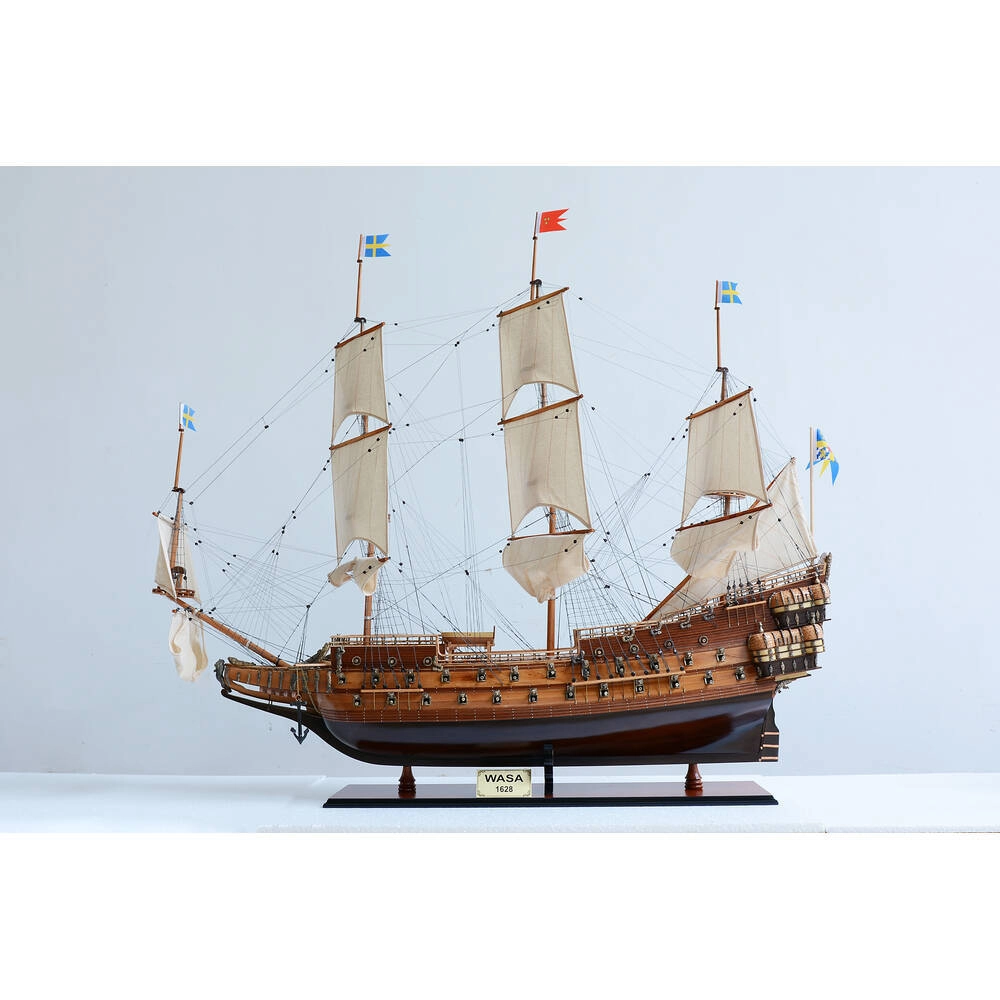Description:
The Wasa XLarge ship model is a remarkable replica of the Swedish warship known for its brief and tragic maiden voyage in 1628, when it sank just a mile off the coast shortly after setting sail. It is meticulously handcrafted from a combination of high-grade woods such as cedar, mahogany, teak, and various other exotic woods, ensuring both durability and a striking aesthetic. The metal components such as the nameplate and detailed metal trimmings are made from corrosion-resistant metal, highlighting the ship's ornate cannons and decorative features with precision. The rigging is finely tuned and accurately represented, with multiple lines and knots that add to the realistic portrayal of this 17th-century warship.
The Wasa model is characterized by its impressive detailing: it features plank-on-frame construction, three detailed decks, and two and a half rows of cannons on each side, reflecting the ship's intended firepower. The bowsprit is adorned with brass statues and other crafted brass ornaments, adding a rich visual texture. The ship includes three large masts, all securely connected with meticulously knotted rigging that has been fastened by hand. The deck is replete with stationed metal cannons, authentic hand-built lifeboats, and an ornate wooden cabin. The admiral’s quarter at the stern is exquisitely detailed with spectacular brass ornaments, demonstrating the craftsman's attention to detail.
This model, perfect for display in offices, homes, or as a centerpiece in collections, not only serves as a decorative item but also as an educational piece that brings to life a significant piece of maritime history. Its grand size and intricate craftsmanship make it an ideal gift for boat enthusiasts, historians, or collectors looking for a museum-quality addition to their collection. Each Wasa XLarge model is a testament to skilled handcrafting, requiring hundreds of hours to complete, ensuring that each piece is not only a model but a piece of art.
History:
The Swedish Warship Vasa (previously Wasa)
Vasa is a Swedish warship that was built between 1626 and 1628, under the reign of King Gustavus Adolphus as part of his military expansions during the war with Poland-Lithuania. The ship was constructed at the Stockholm navy yard and was one of the most heavily armed vessels in the world at the time, equipped primarily with bronze cannons cast specifically for her. Decorated richly as a symbol of the Swedish king's ambitions, Vasa was, however, dangerously top-heavy with excessive weight in the upper structure of the hull.
Maiden Voyage and Sinking
On her maiden voyage on August 10, 1628, Vasa tragically sank just 1,300 meters from her departure point after being hit by a stronger than a breeze wind. The ship's instability was known, but the political pressures and the king's impatience to see her join the naval fleet meant that concerns were not adequately addressed. An inquiry followed her sinking, but no one was held accountable for the disaster. Over the centuries, Vasa fell into obscurity, her bronze cannons salvaged in the 17th century.
Rediscovery and Preservation
It wasn't until the late 1950s that Vasa was rediscovered in the busy shipping lanes of Stockholm harbor. In an ambitious salvage operation in 1961, she was raised with a largely intact hull. After extensive preservation efforts, Vasa was housed in a temporary museum until 1988 before being moved to the Vasa Museum in Stockholm's Royal National City Park. Today, as Scandinavia’s most visited museum, Vasa offers invaluable insights into 17th-century naval warfare, shipbuilding, and daily life through thousands of artifacts recovered with the ship.
Legacy and Impact
Since her recovery, Vasa has become a symbol of the Swedish Empire's era of greatness and serves as a profound educational and cultural resource. The ship's preservation continues, providing critical data for the ongoing study of maritime archaeology and conservation techniques. The story of Vasa reflects the ambitions and the perilous undertakings of maritime states in the early modern period, showcasing both the technological advances and the human challenges of the time.



